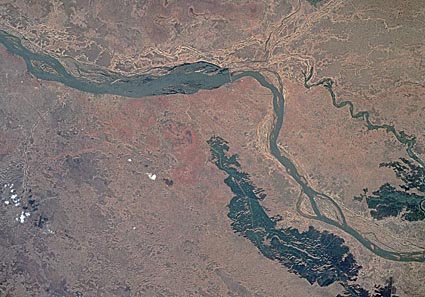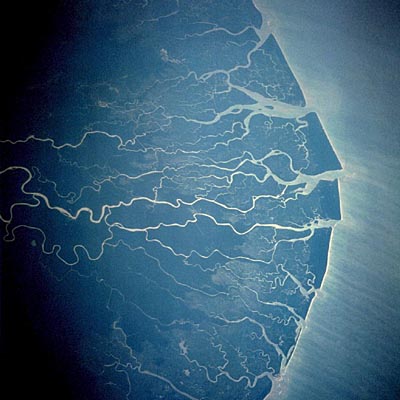|
Location: 5N 5E (West Africa); length: 4200 kilometres (2600 miles); drainage basin: 1.5 million square kilometres (600,000 square miles).
Africa's third longest river, the Niger flows through West Africa to empty into the Gulf of Guinea (Atlantic Ocean). Rising in the Fouta Djalon highlands of Guinea, it flows northeast into Mali, then east and southeast through Mali, Niger, and Nigeria. The first European to explore the river was Mungo Park in 1805.

The Niger near Timbuktu (Timbouctou).
The headwaters experience a dry season and a wet season, and this gives rise to an annual flood that lasts for over a month, called the 'Black Flood'. This flood is absorbed in the huge lakeland and swamp region at the most northerly part of the river's course. This region, upstream of the town of Dire in Mali, is called the Macina. It is in the Sahel, one of Africa's driest regions. So dry is this region that the river flows for over a thousand km without being joined by a major tributary. Only when it flows south into Nigeria, does rain on the Jos Plateau and the Cameroon mountains, provide the runoff for permanent rivers. The largest tributary is the Benue, whose major headwaters are in the rain forests of the Cameroon Highlands. The Niger provides water to an area where local rainfall is unreliable. For this reason, huge attempts have been made to harness the flood and store the water for use through the dry season. The largest of the dams designed for this purpose is the Kainji Dam in Nigeria. The Niger is navigable in all its reaches, although rapids mean that the upper, middle and lower reaches are also cut off from each other. All reaches of the river provide fish, and this is a staple diet of many people who live close to the river. As the Niger approaches the ocean, it spreads out into innumerable distributaries to form the biggest delta in Africa covering an area of about 37,000 square kilometres (14,000 square miles).

The Niger delta.The Niger basin has not been densely settled because of the scarcity of the water, but more reliable water provided by the reservoirs allows irrigated crops to be grown. The delta, which is naturally tropical rain forest, is the only region to be densely populated. Many people rely on tree crops, such as oil palm. The main resources of the delta are, however, not provided by the modern river, but are provided by oil-rich rocks. These, and other offshore oilfields, are the foundation of much of Nigeria's wealth and the source of much internal conflict. |